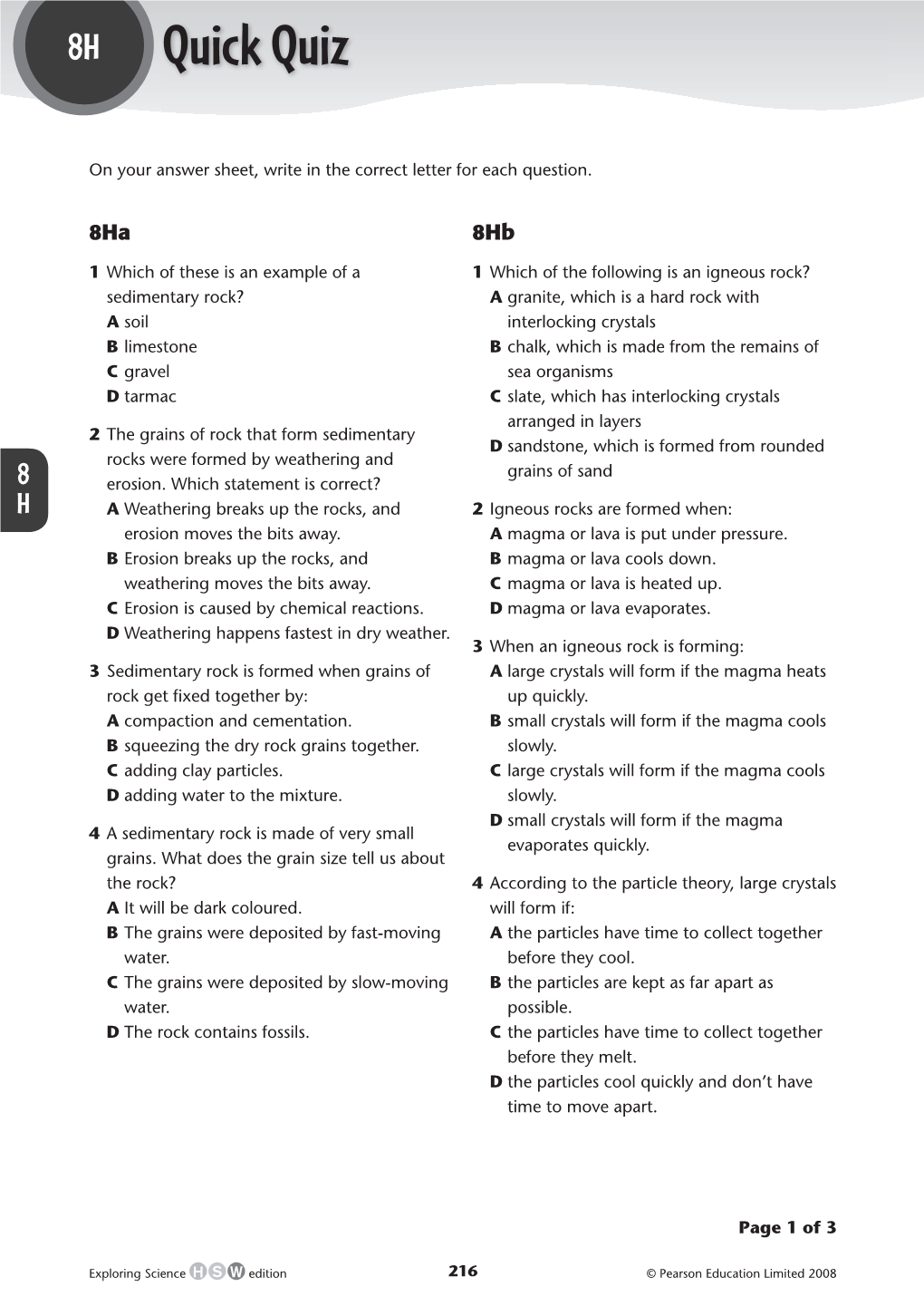8H
Quick Quiz
On your answer sheet, write in the correct letter for each question.
8Ha 8Hb
1 Which of these is an example of a 1 Which of the following is an igneous rock?
A granite, which is a hard rock with interlocking crystals sedimentary rock?
A soil
C gravel
B limestone B chalk, which is made from the remains of sea organisms
D tarmac C slate, which has interlocking crystals arranged in layers
2 The grains of rock that form sedimentary rocks were formed by weathering and erosion. Which statement is correct?
A Weathering breaks up the rocks, and erosion moves the bits away.
D sandstone, which is formed from rounded grains of sand
8
H
2 Igneous rocks are formed when:
A magma or lava is put under pressure.
B magma or lava cools down.
C magma or lava is heated up.
D magma or lava evaporates.
B Erosion breaks up the rocks, and weathering moves the bits away.
C Erosion is caused by chemical reactions.
D Weathering happens fastest in dry weather.
3 When an igneous rock is forming:
A large crystals will form if the magma heats 3 Sedimentary rock is formed when grains of rock get fixed together by: up quickly.
A compaction and cementation.
B squeezing the dry rock grains together.
C adding clay particles.
B small crystals will form if the magma cools slowly.
C large crystals will form if the magma cools slowly.
D adding water to the mixture.
D small crystals will form if the magma evaporates quickly.
4 A sedimentary rock is made of very small grains. What does the grain size tell us about the rock?
4 According to the particle theory, large crystals will form if:
A It will be dark coloured.
B The grains were deposited by fast-moving A the particles have time to collect together water. before they cool.
C The grains were deposited by slow-moving B the particles are kept as far apart as water. possible.
D The rock contains fossils.
C the particles have time to collect together before they melt.
D the particles cool quickly and don’t have time to move apart.
Page 1 of 3
216
Exploring Science edition © Pearson Education Limited 2008 Quick Quiz (continued)
8H
8Hc 8Hd
1 Which rock is a metamorphic rock?
A basalt, which is formed when lava cools 1 What is a scientific theory?
A a description of what a scientist found out down in an experiment
B granite, which has interlocking crystals of B an idea that can explain observations and different sizes be used to make testable predictions
C a prediction of what will happen in an C gneiss, which has interlocking crystals in coloured bands experiment
D mudstone, which is formed from mud particles stuck together
D a story about how the Earth formed
2 Which of these statements is not true?
A The Bible describes how some Christians of: think the Earth was formed.
2 Metamorphic rocks are formed by the effects 8
H
A the high pressure and low temperature B Most rocks on the Earth are older than inside the Earth. 6000 years.
B the high pressure and high temperature C Predictions made using creationism have inside the Earth. been tested and are wrong.
C the low pressure and high temperature D Almost all scientists think that creationism inside the Earth. is a good scientific theory.
D the low pressure and low temperature inside the Earth.
3 Which statement is true?
A The catastrophe theory says that all rocks were formed very slowly.
3 Which of the following statements is true?
A Marble is formed from limestone.
B Marble is not a metamorphic rock.
C Slate is formed from granite.
B Most scientists agree that the catastrophe theory is a good scientific theory.
C Volcanic eruptions are evidence in favour of the catastrophe theory.
D Gneiss is formed from marble.
D There is no evidence in favour of the catastrophe theory.
4 Which statement describes some of the ways in which metamorphic rocks are different from sedimentary rocks?
4 Which statement is true?
A Metamorphic rocks do not contain crystals and are very porous.
A The theory of uniformitarianism says that all rocks were formed by sudden events.
B Scientists think the theory of B Metamorphic rocks are softer, more porous and have large grains. uniformitarianism is correct.
C Metamorphic rocks may be harder, less porous and have crystals that may be lined up.
C Scientists think the theory of uniformitarianism is mostly correct.
D The Earth is too young for
D Metamorphic rocks are softer, less porous and may contain clear fossils. uniformitarianism to be correct.
Page 2 of 3
217
Exploring Science edition © Pearson Education Limited 2008 Quick Quiz (continued)
8H
8He
1 Which of the following is not part of the rock cycle?
A respiration
B weathering
C rocks getting buried underground
D volcanoes erupting
2 Which list shows rock-cycle processes that all happen quickly?
A weathering of rocks, formation of metamorphic rocks
B magma cooling underground, floods
C landslides, sediments being compressed to form rocks
8
H
D earthquakes, lava flowing from a volcano
3 Which list shows rock-cycle processes that all happen slowly?
A volcanoes erupting, landslides
B sediments being compressed to form rocks, weathering of rocks
C floods, magma cooling underground
D formation of metamorphic rocks, earthquakes
4 Rocks can become buried beneath other rocks when:
A physical weathering wears rocks away.
B ice transports bits of rock.
C the plates that make up the Earth’s surface move apart.
D the plates that make up the Earth’s surface push into each other.
Page 3 of 3
218
Exploring Science edition © Pearson Education Limited 2008
Rock Quick Quiz
